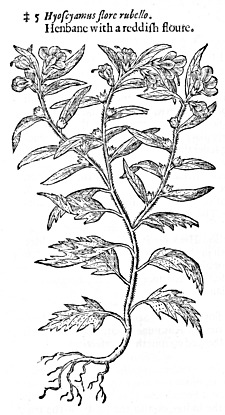
Gerard's Herbal - Part 2
|
|
|
| Fig. 556. Black Henbane (1) |
Fig. 557. White Henbane (2) |
The Description.
1. The common Black Henbane hath great and soft stalks: leaves very broad, soft, and woolly, somewhat jagged, especially those that grow near unto the ground, and those that grow upon the stalk, narrower, smaller, and sharper. The flowers are bell fashion, of a faint yellowish white and brown within towards the bottom; when the flowers are gone, there cometh hard knobby husks, like small cups or boxes, wherein are small brown seeds.
2. The White Henbane is not much unlike to the black, saving that his leaves are smaller, whiter and more woolly, and the flowers also whiter. The cods are like the other, but without pricks; it dieth in winter, and must likewise be sown again the next year.
|
|
|
| Fig. 558. Lesser White Henbane (3) |
Fig. 559. White Henbane of Candy (4) |
3. This other White Henbane is much like the last described, but that it is lesser: the leaves smaller and rounder, hanging upon pretty long stalks, the flowers and seed vessels are like those of the last mentioned.
4. This is softer and tenderer than the last described, the leaves also hang upon long footstalks and are covered over with a soft downiness: and they are somewhat broader, yet thinner and more sinuated than those of the white, and somewhat resemble the form of a vine leaf, being snipped about the edges; the stalks are also covered with a white down. The flowers are of a gold yellow with a velvet coloured circle in their middles: the root is sufficiently rhick and large: Clusius had the figure and description of this from his friend Jacques Plateau, who had the plant growing of seed received from Candy.

Fig. 560. Henbane with a Reddish Flower (5)
5. The stalk of this grows some cubit high, being pretty stiff, about the thickness of one's little finger, and covered over with a soft and white down: the leaves grow dispersed upon the stalk, not much unlike those of the common kind, but lesser and more divided, and white (while they are young) covered with a slender and long downiness: the top of the stalk is divided into certain branches that bend or hang down their heads, which alternately amongst narrower, lesser and undivided leaves carry cups like as the common one, ending in five pretty stiff points, in which are contained flowers at first somewhat like the common kind, but afterwards, as they grow bigger, they change into an elegant red purplish colour, with deep coloured veins: neither is the ring or middle part purple as in the common kind, but whitish, having a purplish pointel, and five threads in the middle: the seeds and seed vessels are like those of the common kind. Clusius received the seed hereof from Paludanus returning from his travels into Syria and Egypt, wherefore he calls it Hyoscyamus Ægyptius, Egyptian Henbane.
The Place.
Black Henbane grows almost everywhere by highways, in the borders of fields, about dung-hills and untoiled places; the white Henbane is not found but in the gardens of those that love physical plants: the which groweth in my garden, and doth sow itself from year to year.
The Time.
They spring out of the ground in May, bring forth their flowers in August, and the seed is ripe in October.
The Names.
Henbane is called of the Latins, Apollinaris, and Faba suilla: the Arabians, as Pliny saith, Altercum: of some, Faba iovis, or Jupiter's bean: of Pythagoras, Zoroastes, and Apuleius Insana, Alterculam, Symphoniaca, and Calicularis: of the Tuscans, Fabulonia, and Faba lupina: of Matthæus Sylvaticus, Dens Caballinus, Milimandrum, Cassilago: of Iacobus de Manliis, Herba pinnula: in shops it is called Insquiamus, and Hyoscyamus: in English, Henbane: in Italian, Hyosquiamo: in Spanish, Velenno: in High Dutch, Bilsen kraut: in French, Hannebane, Endormie: the other is called Hyoscyamus albus, or white Henbane.
The Temperature.
These kinds of Henbane are cold in the fourth degree.
The Virtues.
A. Henbane causeth drowsiness, and mitigateth all kind of pain: it is good against hot and sharp distillations of the eyes and other parts: it stayeth bleeding and the disease in women: it is applied to inflammations of the stones and other secret parts.
B. The leaves stamped with the ointment Populeon, made of poplar buds, assuageth the pain of the gout, and the swellings of the stones, and the tumors of women's breasts, and are good to be put into the same ointment, but in small quantity.
C. To wash the feet in the decoction of Henbane causeth sleep; or given in a clyster it doth the same; and also the often smelling to the flowers.
D. The leaves, seed, and juice taken inwardly causeth an unquiet sleep like unto the sleep of drunkenness, which continueth long, and is deadly to the party.
E. The seed of White Henbane is good against the cough, the falling of watery humours into the eyes or breast; against the inordinate flux of women's issues, and all other issues of blood, taken in the weight of ten grains, with water wherein honey hath been sodden.
F. The root boiled with vinegar, and the same holden hot in the mouth, easeth the pain of the teeth. The seed is used by mountebank tooth-drawers which run about the country, for to cause worms come forth of men's teeth, by burning it in a chafing-dish with coals, the party holding his mouth over the fume thereof: but some crafty companions to gain money convey small lute strings into the water, persuading the patient that those small creeping beasts came out of his mouth or other parts which he intended to ease.